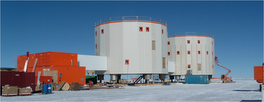Antarctic history revealed by shear wave splitting
![]()
Antarctica is a patchwork of different blocs, which have come together and split apart a number of times before forming the continent as we know it today. The history of this coming and going is written in the fabric of the Antarctic lithosphere, and can be read using standard seismological techniques.
One such technique is shear wave splitting, the investigation of shear wave birefringence through the upper mantle that has been rendered anisotropic by the accumulated effect of millions of years of tectonic processes. By measuring the anisotropy via shear wave splitting, we can attempt to unravel this tectonic history.
Bayer et al. (2007) present results of shear wave splitting measurements carried out on permanent and temporary seismic stations in Dronning Maud Land, Antarctica. They show that the anisotropy varies strongly with position, indicating the presence of distinct lithospheric blocs, separated by a suture that probably cuts through the whole lithosphere.
The anisotropy they find is not consistent with current plate motion, but in general follows the strike of magnetic anomalies, indicating that the crust and mantle were strongly coupled during the major tectonic episodes by which the Antarctic continent was assembled.
At near coastal stations this study agrees with previous research in finding evidence for two superposed layers of seismic anisotropy. The upper layer is consistent with local crustal magnetic anomalies. The lower layer is consistent with the first rifting stages of the Gondwana super-continent, when South Africa separated from the Antarctic continent.
In short, the seismic anisotropy found by shear wave splitting in Donning Maud Land strongly supports a succession of continental collisions, lithospheric extension and fragmentation. As the seismic experiments planned for the International Polar Year take place, there will be data from more locations in Antarctica, and more of the jigsaw puzzle of this frozen continent will fall into place.
References
Bayer, B., Muller, C., Eaton, D.W., Jokat, W. (2007). Seismic anisotropy beneath Dronning Maud Land, Antarctica, revealed by shear wave splitting. Geophysical Journal International, 171(1), 339-351. DOI: 10.1111/j.1365-246X.2007.03519.x
-----
Keep up to date with the latest developments at http://sismordia.blogspot.com




No comments:
Post a Comment